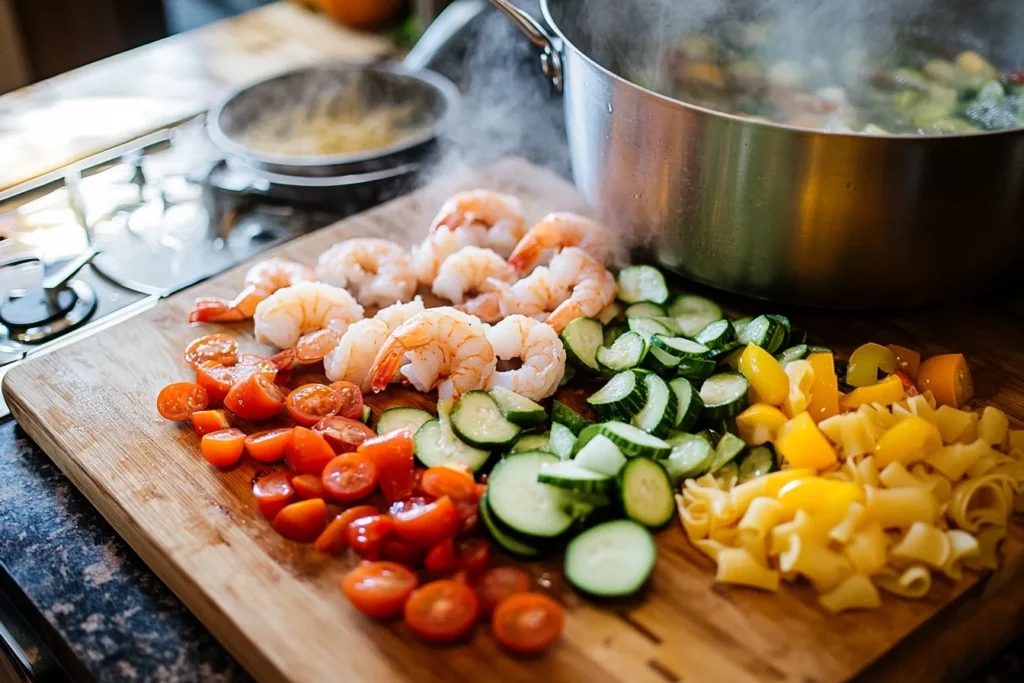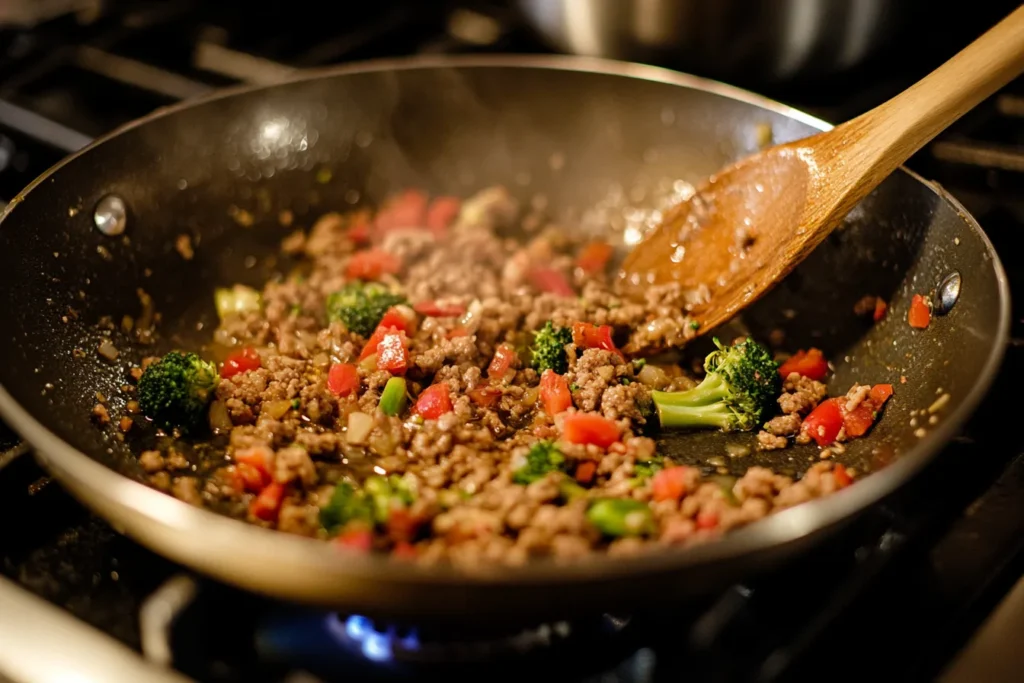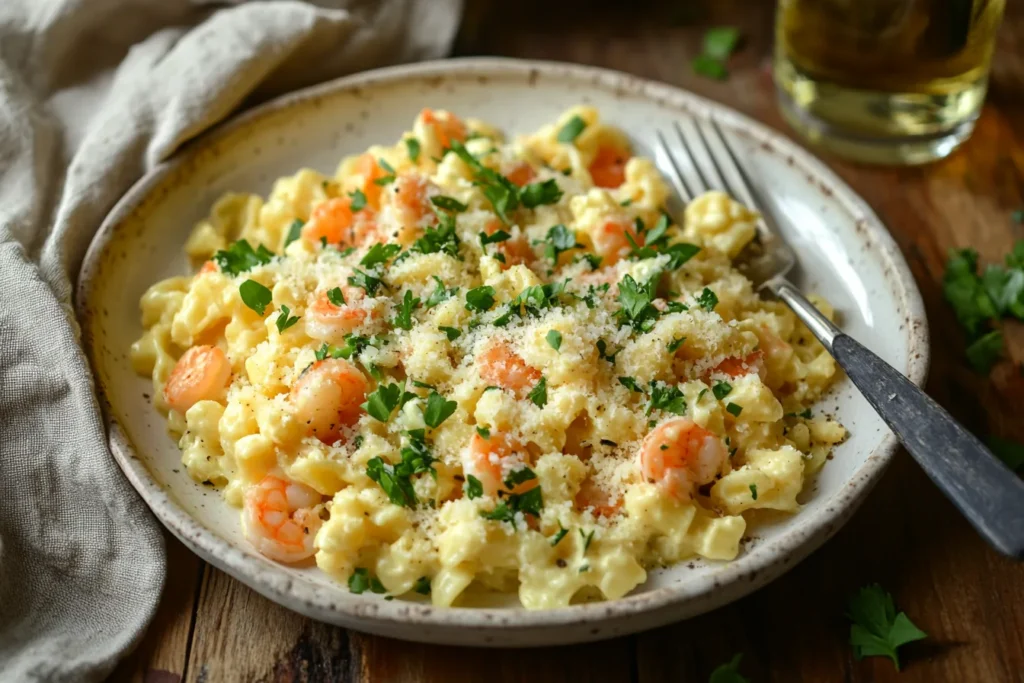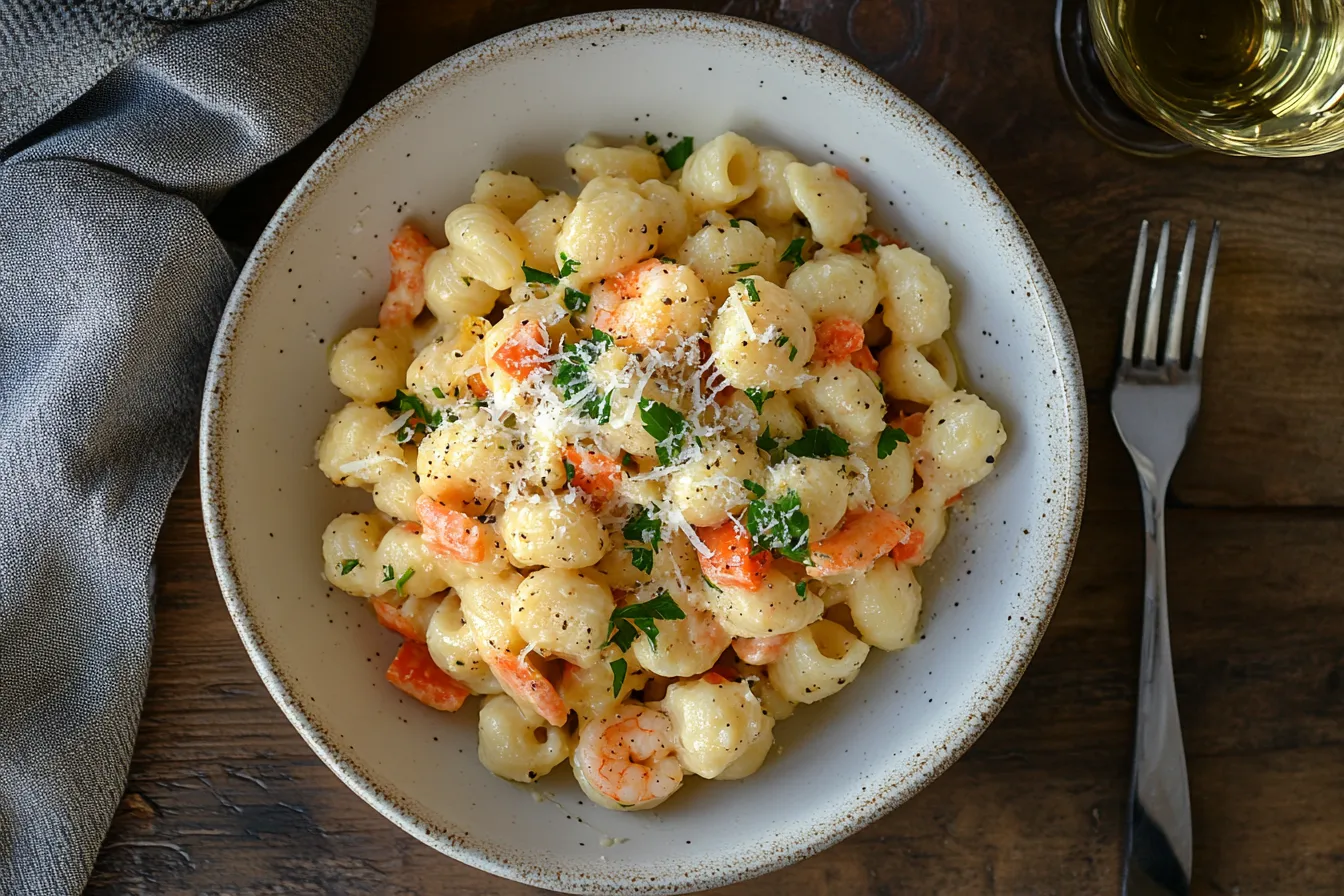Table of Contents
- Introduction
- What is Shrimp Pasta Primavera?
- Ingredients for Shrimp Pasta Primavera
- How to Make Shrimp Pasta Primavera
- Nutritional Information of Shrimp Pasta Primavera
- Variations of Shrimp Pasta Primavera
- Why You Should Try Shrimp Pasta Primavera
- Tips for Perfecting Your Shrimp Pasta Primavera
- Shrimp Pasta Primavera for Special Occasions
- FAQs
- Conclusion
Introduction
Shrimp Pasta Primavera is not just a dish; it’s a celebration of flavors! Combining succulent shrimp with fresh vegetables and pasta, this meal is packed with nutrients and tastes incredible. Perfect for a weeknight dinner or a special occasion, Shrimp Pasta Primavera is versatile, easy to make, and sure to impress. Let’s dive into the delicious world of this vibrant dish!
When you think about pasta dishes, you might picture heavy sauces and lots of cheese. However, Shrimp Pasta Primavera takes a different approach. This dish is light, fresh, and filled with the colors and tastes of spring vegetables. With each bite, you can taste the love and care put into the preparation. So, whether you’re a seasoned chef or a novice in the kitchen, this delightful recipe welcomes everyone to enjoy its deliciousness.
What is Shrimp Pasta Primavera?
Shrimp Pasta Primavera is a delightful Italian-inspired dish that highlights seasonal vegetables and shrimp, all tossed together with pasta. Primavera, meaning “spring” in Italian, reflects the use of fresh vegetables, making this dish ideal for any time of the year. The harmony of flavors, textures, and colors makes it not only appetizing but also visually appealing.
Origin of the Dish
The origins of Pasta Primavera can be traced back to Italian-American cuisine, where the dish began to gain popularity in the mid-20th century. It was created by chefs in New York, who sought to showcase the vibrant vegetables available in spring. Interestingly, the addition of shrimp was likely inspired by the seafood-rich diets of coastal regions in Italy. Consequently, this fusion of ingredients helped create the beloved Shrimp Pasta Primavera we enjoy today.
Key Characteristics
One of the standout features of Shrimp Pasta Primavera is its emphasis on fresh ingredients. The dish is typically characterized by:
- Vibrant vegetables: Bell peppers, zucchini, and asparagus are just a few examples of what you can include.
- Succulent shrimp: The protein adds a delicious flavor and pairs beautifully with the pasta.
- Light seasoning: Rather than heavy sauces, the dish is often lightly seasoned with olive oil, garlic, and fresh herbs, allowing the natural flavors to shine.
This combination results in a dish that’s not only satisfying but also incredibly nourishing.

Ingredients for Shrimp Pasta Primavera
To whip up a delicious Shrimp Pasta Primavera, you’ll need a mix of fresh ingredients. Here’s a comprehensive list:
Basic Ingredients
- Pasta (spaghetti, fettuccine, or your favorite type): This forms the base of the dish and provides the heartiness.
- Shrimp (peeled and deveined): This is the star protein that adds flavor and texture.
- Olive oil (extra virgin for enhanced flavor): The foundation for sautéing and adds a lovely richness.
- Garlic (minced): Garlic is essential for flavoring the dish and imparting a delicious aroma.
- Vegetables (bell peppers, zucchini, broccoli, etc.): Fresh, seasonal vegetables will enhance the dish’s healthfulness and visual appeal.
- Cherry tomatoes (halved): These sweet bursts of flavor complement the savory elements.
- Fresh herbs (like basil or parsley): Fresh herbs add a pop of color and freshness to the dish.
- Salt and pepper (to taste): Basic seasonings that enhance all the ingredients.
- Parmesan cheese (for serving): This adds a salty, nutty flavor that brings the dish together.
Optional Ingredients
- Red pepper flakes (for heat): If you enjoy a bit of spice, consider adding these for a kick.
- Lemon juice (for zestiness): A squeeze of lemon can brighten the overall flavor profile.
Choosing the Best Ingredients
When preparing Shrimp Pasta Primavera, the quality of your ingredients makes a significant difference. For example, opt for fresh, seasonal vegetables whenever possible. Not only do they taste better, but they also provide more nutrients. When it comes to shrimp, choose medium to large-sized shrimp for a satisfying bite. Additionally, buying shrimp that is sustainably sourced can help support responsible fishing practices.
How to Make Shrimp Pasta Primavera
Now that we have our ingredients, let’s get cooking! Follow these easy steps to create a flavorful Shrimp Pasta Primavera.
1: Cook the Pasta
- Boil a large pot of salted water. Once it reaches a rolling boil, add your pasta of choice.
- Cook according to package directions until al dente. It’s crucial not to overcook the pasta; you want it to have a slight bite.
- Drain and set aside, reserving a cup of pasta water. This starchy water can be beneficial for adjusting the sauce later.
2: Sauté the Vegetables
- In a large skillet, heat olive oil over medium heat. Be careful not to let the oil smoke.
- Add minced garlic and sauté until fragrant, about 1 minute. However, keep an eye on it; burnt garlic can taste bitter.
- Toss in your choice of vegetables, starting with the ones that take the longest to cook, like broccoli or bell peppers. Cook until slightly tender, about 5-7 minutes. You want them to retain some crispness for texture.

3: Add the Shrimp
- Add the shrimp to the skillet. Because shrimp cook quickly, you’ll want to add them after the vegetables have begun to soften.
- Cook until the shrimp turn pink and opaque, about 3-4 minutes. Not only that, but the shrimp will also release their natural flavors into the dish.
- Season with salt, pepper, and optional red pepper flakes. Stir well to combine.
4: Combine Everything
- Add the cooked pasta to the skillet, mixing well to incorporate all the flavors. Additionally, if the mixture seems dry, add a bit of reserved pasta water to moisten it.
- Finish with fresh herbs and a squeeze of lemon juice, if desired. This will enhance the dish with a refreshing taste.
5: Serve
- Plate the Shrimp Pasta Primavera. Serve it warm, topped with freshly grated Parmesan cheese.
- Drizzle a little extra olive oil on top for added richness, and enjoy your delicious creation!
Nutritional Information of Shrimp Pasta Primavera
Here’s a quick look at the nutritional data for a serving of Shrimp Pasta Primavera (approximately 1 cup):
| Nutrient | Amount per Serving |
|---|---|
| Calories | 350 |
| Protein | 25 g |
| Carbohydrates | 45 g |
| Fat | 10 g |
| Fiber | 4 g |
| Sugars | 3 g |
| Sodium | 450 mg |
Health Benefits
Shrimp Pasta Primavera offers several health benefits. For example, the shrimp provides a high-quality source of protein, essential for muscle repair and growth. The variety of vegetables contributes dietary fiber, which aids digestion and promotes a feeling of fullness. Furthermore, incorporating olive oil adds healthy fats that are good for heart health.
Also, this dish is low in calories compared to many traditional pasta dishes, especially since it relies on fresh ingredients rather than heavy sauces. Consequently, it can be a fantastic option if you’re looking to maintain a balanced diet without sacrificing flavor.

Variations of Shrimp Pasta Primavera
Vegetable Variations
- Swap out standard vegetables: You can use whatever veggies you have on hand! Seasonal favorites like asparagus, snap peas, or carrots work wonderfully. Similarly, leafy greens such as spinach or arugula can be added for extra nutrients and flavor.
- Go for a colorful mix: The more colors on your plate, the more nutrients you’re likely to consume. Try incorporating red cabbage, yellow squash, or even peas for a rainbow effect.
Protein Variations
- Replace shrimp with chicken: If you’re not a fan of seafood, consider using diced chicken breast instead. Cook it until golden, then follow the same steps as with shrimp.
- Try scallops or tofu: Scallops can add a touch of elegance, while tofu makes for a great vegetarian protein option. Remember to press the tofu to remove excess moisture before cooking.
Sauce and Flavor Variations
- Add a splash of white wine: If you enjoy a touch of richness, consider adding a splash of white wine after sautéing the garlic. Let it simmer for a minute before adding the shrimp. This will enhance the overall flavor profile.
- Cream sauce twist: For a decadent variation, mix in a little heavy cream or mascarpone cheese at the end for a creamy sauce. This will transform the dish into a luxurious meal.
Why You Should Try it
Not only is Shrimp Pasta Primavera a feast for the senses, but it’s also a fantastic way to incorporate more vegetables into your diet. The vibrant colors and fresh ingredients promise a delicious meal that’s as good for your body as it is for your taste buds. So, gather your ingredients, and get ready to impress your family or friends with this delightful dish!
A Meal for All Occasions
Shrimp Pasta Primavera is incredibly versatile. For example, it can easily be dressed up for a fancy dinner party or simplified for a casual weeknight meal. Because of its vibrant colors and fresh ingredients, it makes a striking presentation, ensuring it will be a hit with guests.
However, its simplicity also makes it an excellent option for weeknight dinners, as it can be prepared in about 30 minutes. Therefore, whether you’re cooking for a crowd or just for yourself, it fits the bill perfectly.
Suitable for Various Dietary Needs
Additionally, Shrimp Pasta Primavera can be adapted to fit various dietary preferences. If you’re looking to cut carbs, consider serving it over zucchini noodles instead of traditional pasta. Similarly, gluten-free pasta options are widely available and can easily replace regular pasta. This flexibility ensures that everyone can enjoy this delicious dish, regardless of dietary restrictions.
Tips for Perfecting Your Shrimp Pasta Primavera
Creating the perfect Shrimp Pasta Primavera may seem simple, but with a few tips, you can elevate your dish to restaurant-quality standards.
Choose the Right Pasta
While you can use any pasta, long strands like spaghetti or fettuccine are particularly suited for this dish. However, if you prefer a different shape, feel free to experiment! Short pasta shapes like penne or fusilli can also hold onto the sauce beautifully.
Don’t Overcook the Shrimp
Overcooking shrimp can lead to a rubbery texture. Therefore, remove them from heat as soon as they turn pink and opaque. It’s better to err on the side of undercooking slightly, as they will continue cooking once removed from the heat.
Use Fresh Ingredients
Using fresh, seasonal ingredients can significantly enhance the flavors of your dish. For example, visiting a local farmer’s market can yield fresh vegetables that taste amazing. Not only will they boost the dish’s flavor, but they’ll also add nutritional value.
Don’t Skip the Pasta Water
The starchy pasta water is a secret tool in many Italian kitchens. If your dish seems dry, adding a splash of reserved pasta water can help create a silky sauce that clings to the pasta beautifully.
Shrimp Pasta Primavera for Special Occasions
Dinner Parties
Imagine serving it at your next dinner party. Not only will it impress your guests, but it can also be made in advance. Prepare the pasta and vegetables ahead of time, then toss everything together just before serving.
Romantic Dinners
On date night, this light yet flavorful dish can set the perfect mood. Consider pairing it with a crisp white wine, such as Pinot Grigio, that complements the shrimp and vegetables beautifully.
Celebratory Gatherings
For gatherings like birthdays or anniversaries, you can elevate the dish even further by serving it family-style in a large bowl. This encourages sharing and creates an inviting atmosphere. Additionally, adding a fresh salad and some garlic bread can round out the meal perfectly.
Frequently Asked Questions
1. What type of pasta goes best with seafood?
When it comes to pairing pasta with seafood, options like linguine, spaghetti, and fettuccine are popular choices. Linguine is particularly effective for holding onto sauces and works well with shrimp or mussels, while spaghetti is classic for light sauces, such as those made with clams. Fettuccine, on the other hand, pairs beautifully with cream-based sauces and scallops.
2. Can I use any seafood with pasta?
Absolutely! You can use a variety of seafood, including shrimp, clams, mussels, scallops, and even fish fillets. The key is to select seafood that complements the pasta and sauce you’re using. For instance, light fish works well with creamy sauces, while shellfish pairs nicely with tomato-based or olive oil sauces.
3. How can I make my pasta and seafood dish healthier?
To make your pasta and seafood dish healthier, consider using whole grain pasta for added fiber and nutrients. Incorporate a variety of vegetables, such as spinach, cherry tomatoes, or bell peppers, to enhance the nutritional value. Additionally, opt for lighter sauces made with olive oil, garlic, and fresh herbs instead of heavy cream sauces.
4. How do I prevent seafood from becoming tough in pasta dishes?
To prevent seafood from becoming tough, it’s essential not to overcook it. Cook shrimp until they are just pink and opaque, and sear scallops until they develop a golden crust without extended cooking. Generally, seafood cooks quickly, so it’s best to add it to your dish just a few minutes before serving.
5. What sauces pair well with seafood pasta?
Light sauces, such as garlic and olive oil, white wine with lemon, and marinara are excellent choices for seafood pasta. Creamy sauces, like Alfredo or a lemon-butter sauce, also pair well, particularly with richer seafood like scallops or crab. Additionally, a pesto sauce can add a fresh, flavorful twist.
6. Can I prepare seafood pasta in advance?
While pasta can be cooked in advance and reheated, seafood is best when fresh. If you plan to make the dish ahead of time, consider cooking the pasta and seafood separately. Store them in the refrigerator and combine them just before serving to maintain the best flavor and texture.
7. Is it safe to reheat seafood pasta?
Yes, it is generally safe to reheat seafood pasta, but it’s important to do so properly to maintain quality. Reheat gently in a skillet over low heat with a splash of water or broth to prevent drying out. Ensure seafood reaches an internal temperature of 145°F (63°C) to ensure safety.
8. What are some popular seafood pasta dishes I can try?
Some popular seafood pasta dishes include:
- Spaghetti alle Vongole (spaghetti with clams)
- Linguine alle Vongole (linguine with clams)
- Shrimp Scampi (shrimp in garlic and butter sauce with pasta)
- Fettuccine Alfredo with Scallops
- Penne Alla Puttanesca (penne with tomatoes, olives, and anchovies)
9. What are some tips for cooking the perfect pasta?
To cook the perfect pasta, start with a large pot of boiling water and use plenty of salt to flavor the pasta. Add the pasta and stir occasionally to prevent sticking. Cook until al dente, which means the pasta is tender but still firm to the bite. Reserve some pasta water before draining; it can help thicken and adjust the sauce’s consistency.
10. Are there vegetarian options for pasta and seafood dishes?
While traditional seafood pasta dishes contain animal products, you can create delicious vegetarian alternatives using plant-based seafood products or by simply focusing on pasta with vegetables and plant-based sauces. Consider making a hearty pasta primavera with seasonal vegetables or a flavorful marinara with added beans or lentils for protein.
Conclusion
In just a short time, you can create a satisfying meal that’s packed with flavor and nutrition. Shrimp Pasta Primavera is not just about the ingredients; it’s about the joy of cooking and sharing a delicious dish with loved ones. So, give it a try today, and savor the taste of spring all year round!
Whether you’re making it for a special occasion or just a regular Tuesday night dinner, Shrimp Pasta Primavera is bound to become a go-to favorite in your kitchen. With its vibrant colors, delightful flavors, and nutritional benefits, you’ll find yourself returning to this recipe time and again. Happy cooking!

